Huskemaw 5-20 LR Scope Review
By Ernie Bishop
I remember my first thoughts when I heard about this new Huskemaw 5-20 LR Rifle scope being on the market. One of my first questions was, "What does it have to offer that other scopes on the market don't already have?" I guess in some ways I am a skeptic when it comes to the latest and greatest product whether it be concerning long range hunting or some other arena. To let the cat out of the bag, I can honestly say I was pleasantly surprised.
For those of you who do not know much about me, understand I use and own a number of other brand name long range optics with a variety of reticles. In other words, I am not stuck on one brand of scope. I am sure that the heated discussions over what is the best scope for long range hunting will continue. My goal in this review is not to tell you which long range hunting scope is the best, but to share my findings on the Huskemaw scope.
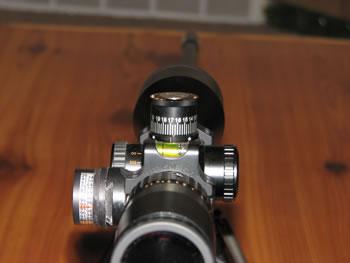
So, with that in mind, let's get to the business of reviewing a scope which is now a part of my collection for long range hunting. When I first opened the box for this review, the first thing I noticed was the size of the Huskemaw scope; it is relatively short for a long range optic of its kind, only 13.7 inches. For comparison's sake, the Leupold VX-3 6.5-20x50mm LRT is 14.4 inches long, and the Nightforce NXS 5.5-22x50mm is 15.1 inches, respectively. The objective lens of the Huskemaw scope is a 50 mm and it weighs 23 ounces. The Huskemaw has a 30 mm tube, which is consistent with most of the upper level long range hunting optics today. Weight is 23 ounces compared to 20.4 ounces for the Leupold scope, and 31 ounces for the Nightforce scope mentioned above. I use the optics for comparison purposes, since one or both will be familiar to those reading this review.
I took the Huskemaw scope outside and looked through it for awhile, messing around with magnification and parallax adjustments like all good hunters do or should do. Then, I went inside and did something that evening I had never done before. I read the instructions! It is not like I never read the instructions, but after so many scopes, you glance at it, and it is basically the same for all practical purposes. What caught my attention about the Huskemaw scope's instructions is that it was more like a booklet (more than 20 pages) than your typical scope owner's manual. I never thought I would ever make a comment like this about an optic, but Huskemaw's owner manual is the most impressive that I have ever looked at. I am not saying it is best because it has more pages, but because it is the most thorough I have ever looked at. A DVD is included with the instruction guide. With both of these tools, it will allow a beginner to understand Huskemaw's new scope and its features to the point of making first shot connections at long range.
The information that Huskemaw has given is informational, easy to understand, and practical. You may be thinking to yourself, "Get on with the review of the scope and quit talking about an owner's manual." For those of you who have been shooting at long range for a period of time successfully may not need this kind of information. I receive regular correspondence from those who are thinking about getting into the game or have recently started. The information presented in the Huskemaw manual and DVD would answer many of their questions. I even had Aaron Davidson from Best of the West send me an extra manual and DVD for that very purpose for some of my friends who live in this area who are considering a long range scope.
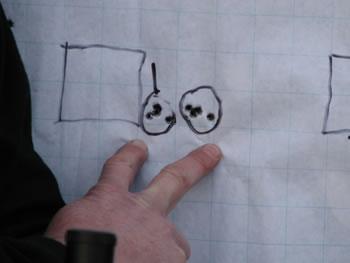
My first time out with the Huskemaw 5-20 LRH Scope was back in April when longtime hunting buddy, Steve Hugel, came up for a couple of days. First, we went to the local range and did some load development for a rear-grip XP-100 @ 200 yards on paper. I was using four-shot groups, and two of the groups were in the .4 inch range and the other was in the .5 inch range. I am always pleased when I shoot ½ inch or better at 200 yards. Then we went out of town and put steel up at 546 yards, 730 yards, and 799 yards. There were two 11" circular steel plates at the closer distances and a 10" x 20" rectangular plate at 799 yards. All shooting at these distances was from the prone position.
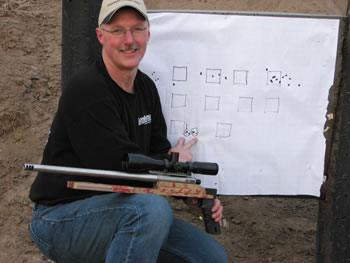
On this date and at times since then, the Huskemaw scope tracked perfectly on two different Remington XP-100's and an MOA Maximum handgun. On the first day in the field, I had a nice 4-shot group that was in the 4" range at 730 yards with a 5th shot taking me to a 9"-10" group. The wind caught me on the fifth shot - Oh well! By the time we moved out to 799 yards, the wind decided to give lessons in humility, with some incredible updrafts that the spotters were able to see via vapor trails. It wasn't the scope's fault that I didn't have good groups; I completely missed the target a couple of times. Even with an accurate rig, great optics, and spotters, you can still be put in your place quickly due to gusty winds that are switching back and forth. Do I trust the reliability of the Huskemaw scope's turret system and its ability to hold zero? Yes!
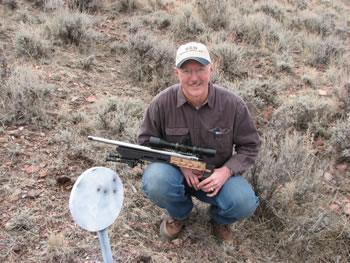
On another day I was able to go to a different rancher's place to compare scopes (Leupold's new VX-3 8.5-25 LRT, Nightforce NXS 5-22, Sightron S-3 6-24, and the Huskemaw 5-20). I had a friend with me on this day as well. I don't claim to be a scope expert, but here is my experience which was echoed by others who compared these scopes on this day as well as on a few others. Since the Huskemaw scope had the lowest upper magnification, we set all of the other scopes' magnification on 20x. When looking at antelope from 1,000-1,200 yards from mid-day to late afternoon, the Huskemaw scope was on par with the Nightforce and the Leupold scopes. The Sightron scope took a noticeable last place. The color contrast on the antelope was noticeably better with the Huskemaw scope versus the Sightron. I have used the Sightron for long range prairie dogging past 1,000 yards successfully and have used it in a 3-day long range competition, but optically it does not stand up to the Huskemaw scope in these areas. When looking at a structure at 45 minutes past sunset, all four of the scopes did well. With that being said, I expect some will disagree with my findings, as we all have our favorites. I admit that some of my results were surprising even to me, but that is my findings with these four scopes. More than anything, I am pleased to see that another well thought out, high quality long range hunting scope is available for sportsmen.
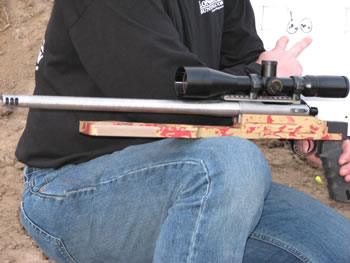
Another debate that can be quite polarizing among long-range shooters is dialing versus using ballistic reticle, MOA reticle, or Mil-Radian reticle. Those who dial will divide over whether to use a turret that is listed in MOA or Mil-Radians versus a BDC (Bullet Drop Compensator) turret cap. The Huskemaw scope is designed for those who want to dial the yardage and can use the reticle or dial for doping the wind.
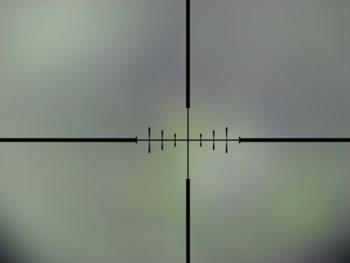
The yardage and the MOA wind correction for a 10 mph crosswind (at 20x if using the reticle), is listed on the turret. Once you have done your homework and filled out the Manual Data Sheet and send it to Huskemaw Optics in Cody, WY, you will soon have your own RFBC. Now, you determine range to target, check wind, dial the distance, hold off for wind on the reticle and shoot.
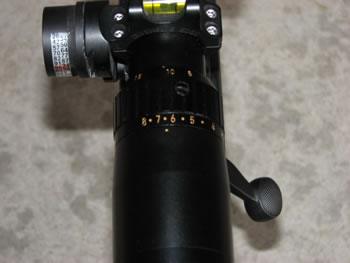
By Ernie Bishop
I remember my first thoughts when I heard about this new Huskemaw 5-20 LR Rifle scope being on the market. One of my first questions was, "What does it have to offer that other scopes on the market don't already have?" I guess in some ways I am a skeptic when it comes to the latest and greatest product whether it be concerning long range hunting or some other arena. To let the cat out of the bag, I can honestly say I was pleasantly surprised.
For those of you who do not know much about me, understand I use and own a number of other brand name long range optics with a variety of reticles. In other words, I am not stuck on one brand of scope. I am sure that the heated discussions over what is the best scope for long range hunting will continue. My goal in this review is not to tell you which long range hunting scope is the best, but to share my findings on the Huskemaw scope.
I have hunted 4 seasons using the Huskemaw scopes. I like the optical quality, the custom yardage turrets. I also like the smaller dimensions and weight compared to what I was using. Sure I make money by promoting my sales of them. But believe me, using a really good scope on my hunts is way, way more important to me than making a few bucks selling scopes. And this one is VERY good.
-- Len Backus, Publisher of LRH

So, with that in mind, let's get to the business of reviewing a scope which is now a part of my collection for long range hunting. When I first opened the box for this review, the first thing I noticed was the size of the Huskemaw scope; it is relatively short for a long range optic of its kind, only 13.7 inches. For comparison's sake, the Leupold VX-3 6.5-20x50mm LRT is 14.4 inches long, and the Nightforce NXS 5.5-22x50mm is 15.1 inches, respectively. The objective lens of the Huskemaw scope is a 50 mm and it weighs 23 ounces. The Huskemaw has a 30 mm tube, which is consistent with most of the upper level long range hunting optics today. Weight is 23 ounces compared to 20.4 ounces for the Leupold scope, and 31 ounces for the Nightforce scope mentioned above. I use the optics for comparison purposes, since one or both will be familiar to those reading this review.
I took the Huskemaw scope outside and looked through it for awhile, messing around with magnification and parallax adjustments like all good hunters do or should do. Then, I went inside and did something that evening I had never done before. I read the instructions! It is not like I never read the instructions, but after so many scopes, you glance at it, and it is basically the same for all practical purposes. What caught my attention about the Huskemaw scope's instructions is that it was more like a booklet (more than 20 pages) than your typical scope owner's manual. I never thought I would ever make a comment like this about an optic, but Huskemaw's owner manual is the most impressive that I have ever looked at. I am not saying it is best because it has more pages, but because it is the most thorough I have ever looked at. A DVD is included with the instruction guide. With both of these tools, it will allow a beginner to understand Huskemaw's new scope and its features to the point of making first shot connections at long range.
The information that Huskemaw has given is informational, easy to understand, and practical. You may be thinking to yourself, "Get on with the review of the scope and quit talking about an owner's manual." For those of you who have been shooting at long range for a period of time successfully may not need this kind of information. I receive regular correspondence from those who are thinking about getting into the game or have recently started. The information presented in the Huskemaw manual and DVD would answer many of their questions. I even had Aaron Davidson from Best of the West send me an extra manual and DVD for that very purpose for some of my friends who live in this area who are considering a long range scope.

My first time out with the Huskemaw 5-20 LRH Scope was back in April when longtime hunting buddy, Steve Hugel, came up for a couple of days. First, we went to the local range and did some load development for a rear-grip XP-100 @ 200 yards on paper. I was using four-shot groups, and two of the groups were in the .4 inch range and the other was in the .5 inch range. I am always pleased when I shoot ½ inch or better at 200 yards. Then we went out of town and put steel up at 546 yards, 730 yards, and 799 yards. There were two 11" circular steel plates at the closer distances and a 10" x 20" rectangular plate at 799 yards. All shooting at these distances was from the prone position.

On this date and at times since then, the Huskemaw scope tracked perfectly on two different Remington XP-100's and an MOA Maximum handgun. On the first day in the field, I had a nice 4-shot group that was in the 4" range at 730 yards with a 5th shot taking me to a 9"-10" group. The wind caught me on the fifth shot - Oh well! By the time we moved out to 799 yards, the wind decided to give lessons in humility, with some incredible updrafts that the spotters were able to see via vapor trails. It wasn't the scope's fault that I didn't have good groups; I completely missed the target a couple of times. Even with an accurate rig, great optics, and spotters, you can still be put in your place quickly due to gusty winds that are switching back and forth. Do I trust the reliability of the Huskemaw scope's turret system and its ability to hold zero? Yes!

On another day I was able to go to a different rancher's place to compare scopes (Leupold's new VX-3 8.5-25 LRT, Nightforce NXS 5-22, Sightron S-3 6-24, and the Huskemaw 5-20). I had a friend with me on this day as well. I don't claim to be a scope expert, but here is my experience which was echoed by others who compared these scopes on this day as well as on a few others. Since the Huskemaw scope had the lowest upper magnification, we set all of the other scopes' magnification on 20x. When looking at antelope from 1,000-1,200 yards from mid-day to late afternoon, the Huskemaw scope was on par with the Nightforce and the Leupold scopes. The Sightron scope took a noticeable last place. The color contrast on the antelope was noticeably better with the Huskemaw scope versus the Sightron. I have used the Sightron for long range prairie dogging past 1,000 yards successfully and have used it in a 3-day long range competition, but optically it does not stand up to the Huskemaw scope in these areas. When looking at a structure at 45 minutes past sunset, all four of the scopes did well. With that being said, I expect some will disagree with my findings, as we all have our favorites. I admit that some of my results were surprising even to me, but that is my findings with these four scopes. More than anything, I am pleased to see that another well thought out, high quality long range hunting scope is available for sportsmen.

Another debate that can be quite polarizing among long-range shooters is dialing versus using ballistic reticle, MOA reticle, or Mil-Radian reticle. Those who dial will divide over whether to use a turret that is listed in MOA or Mil-Radians versus a BDC (Bullet Drop Compensator) turret cap. The Huskemaw scope is designed for those who want to dial the yardage and can use the reticle or dial for doping the wind.

The yardage and the MOA wind correction for a 10 mph crosswind (at 20x if using the reticle), is listed on the turret. Once you have done your homework and filled out the Manual Data Sheet and send it to Huskemaw Optics in Cody, WY, you will soon have your own RFBC. Now, you determine range to target, check wind, dial the distance, hold off for wind on the reticle and shoot.

You can buy a Huskemaw scope at the LRH Store
Huskemaw 5-20 LR Scope Review
When it comes to long range hunting, we assume it is at distance that you are capable of shooting accurately under those field conditions. The Huskemaw turret is called a Rapid Field Ballistic Compensator or simply the RFBC.
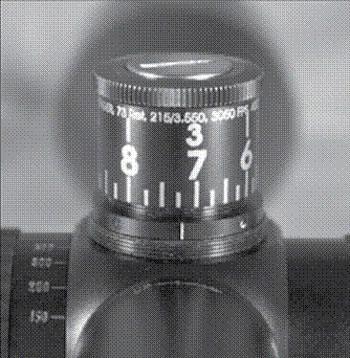
The Huskemaw turrets are custom built for your own gun based on the actual trajectory and the atmospheric conditions where you will be hunting or shooting. The turret cap will list your cartridge, MV, bullet, BC, elevation, and temperature, etc. When you get the scope, the instruction manual and DVD will walk you through everything you need to do to get the correct information so the RFBC will be perfectly set-up for your rifle and ammunition. If needed, give the folks at Best of the West a call or email for further information.
You can buy a Huskemaw scope at the LRH Store
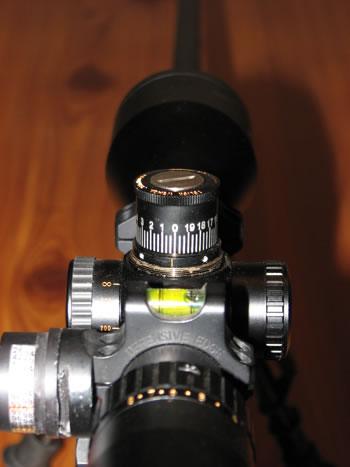
An important feature of the Huskemaw scope is it allows you to adjust 20 MOA with one revolution (1/3 MOA clicks) of the turret. As a standard feature, all Huskemaw scopes come with an adjustable Zero Index Ring (zero stop). When shooting at long range, it is easy to get confused on which revolution you are on. The less MOA per revolution, the easier it is to get confused. Nightforce has 10 MOA per revolution while Leupold has 15 MOA per revolution. If you use 20 MOA of vertical adjustment from a 200 yard zero, with typical LR cartridges, it will take most long range hunters to their self-imposed maximum distance on big game.
For example, a typical LR hunting load would be a 180 grain Berger VLD with a muzzle velocity of 2850 fps, elevation 4,500 feet, 200 yard zero, with the temperature being 40 degrees, and 30% humidity. These conditions are typical for the area around Gillette, Wyoming. In this instance, one full revolution (20 MOA) with the Huskemaw scope turret will be dead on at 920 yards. Some of you use cartridges that will be under or over this example. I know we have hunters that can ethically take animals past the distance listed in my example, but I would guess that the majority of hunters, who are members, make most of their shots under 900 yards on big game. Since the Huskemaw scope has approximately 67 MOA of vertical adjustment, it is not an issue for this optic to shoot beyond 1,000 yards. Many long range hunters use a sloped base, inserts in their rings or both to maximize the useable internal adjustment of their scope, and the same can be done for the Huskemaw scope. One complaint I have heard about the Huskemaw scope is that 1/3 MOA adjustments are too coarse to be accurate for long range hunting.
Let's consider two different ranges: 500 and 1,000 yards. Many scopes used for long range hunting have 1/4 MOA turret adjustments.
One MOA at 500 yards is approximately 5.2 inches, so ¼ MOA is 1.3 inches.
One third MOA at 500 yards is 1.7 inches.
The difference is .4 of an inch at 500 yards.
One MOA at 1,000 yards is 10.47 inches.
One quarter MOA at 1,000 yards is 2.6 inches, while 1/3 MOA at 1,000 yards is 3.49 inches (say 3.5").
The difference between the two is .9 of an inch or 9/10 of an inch.
Which one of you can truly discern 9/10" point of impact change, when shooting one cold bore shot at 1,000 yards in field conditions? If you can, that is outstanding, but I know I am not that good.
Terrain and wind conditions are much more of an issue for me in the field or on the bench at 1,000 yards.
With the load I listed earlier, I changed the "sight adjustment specifications" in Exbal:
1/10 MOA adjustment and at 1,000 yards it would be 22.80 MOA
1/8 MOA adjustment it would be 22.88 MOA
¼ MOA it would be 22.75 MOA
1/3 MOA and the adjustment would be 23 MOA
The 1/3 MOA scope in this instance would be .12 MOA different than the 1/8 MOA scope or .20 MOA from the 1/10 MOA scope.
The ¼ MOA is .05 from the 1/10 MOA scope and .13 MOA from the 1/8 MOA scope.
So, when does the 1/3 MOA scope or the ¼ MOA scope become to coarse for long range hunting?
I don't claim to have all the answers, but I am convinced that the Huskemaw 5-20 LR rifle scope is sufficient for 1,000 yard kills, given the cartridge/bullet combo is capable and the one running it is skilled, under good conditions.
A legitimate concern for customized turret caps is what do you do when you get a turret cap for one set of conditions and then hunt under different ones. As an example, the original Huskemaw RFBC is customized for a 200 yard zero, 1,000 feet elevation and 75 degrees, 50% humidity. It will take 16.25 MOA for "Joe Hunter" to connect at 800 yards. Joe has been practicing at home and has become very proficient. He is preparing to travel to the Big Horns in Wyoming for an elk hunt in the fall. He will be hunting in an area where a local who used to be his neighbor has told him some big bulls hang out. Don't you wish you had friends like this? He has determined the conditions where the elk hang out are 9,000 feet above sea level, 27 degrees, and 20% humidity. He knows bullet flight is going to change, but how much?
Joe has several options. He can order another RFBC turret for the conditions he will hunt in. Joe could also order a 1/3 MOA turret cap from Best of the West that is a typical MOA turret cap, listed in MOA from 0-20 MOA. On a side note, if you are constantly switching loads or you continually move your Huskemaw scope from gun to gun, the traditional turret listed in MOA is something you will want for sure. A third option is for Joe to use his existing Huskemaw RFBC if he so chooses. In the new conditions at 800 yards, it only takes 15 MOA. Joe's maximum range under ideal conditions is 800 yards. The difference in vertical drop is 1.25 MOA or approximately 10 inches. Joe can determine the amount of adjustment that is needed at, say, 3/4 of his max expected range, which we will say is 600 yards. The difference at 600 yards between the two different conditions is .62 MOA. Joe can re-zero at 600 yards; this is simple to do even in the field. Just use a coin or cartridge case to turn and remove the flat silver screw on the top of the turret cap. Then move the turret cap 2 clicks (2/3 MOA or .66 MOA) and replace the cap. Total time spent…15 seconds. Joe's scope/gun/load combo now will be in the kill zone of his elk out to his maximum distance in good conditions. Of course, Joe will confirm his zeros once he gets to his neighbor's house in the Big Horns.
The rest will be determined by Joe's skill as a long range hunter, luck of the day, and his mental and physical conditioning. What would I do? For one thing, having one RFBC does not hamstring "Joe Hunter" as some would suppose. For the amount of money spent for an out of state elk hunt, I would order a new Huskemaw RFBC turret or use my 1/3 MOA turret. You get one custom RFBC turret free from Huskemaw with the purchase of the scope, and a spare one costs $99.99. I would go with the Huskemaw RFBC set-up for the conditions, so I would have one less thing to think about when the moment of truth comes. That is just the way I am wired. Maybe this scope is not as limited as some would have us think.

The Huskemaw turrets are custom built for your own gun based on the actual trajectory and the atmospheric conditions where you will be hunting or shooting. The turret cap will list your cartridge, MV, bullet, BC, elevation, and temperature, etc. When you get the scope, the instruction manual and DVD will walk you through everything you need to do to get the correct information so the RFBC will be perfectly set-up for your rifle and ammunition. If needed, give the folks at Best of the West a call or email for further information.
You can buy a Huskemaw scope at the LRH Store

An important feature of the Huskemaw scope is it allows you to adjust 20 MOA with one revolution (1/3 MOA clicks) of the turret. As a standard feature, all Huskemaw scopes come with an adjustable Zero Index Ring (zero stop). When shooting at long range, it is easy to get confused on which revolution you are on. The less MOA per revolution, the easier it is to get confused. Nightforce has 10 MOA per revolution while Leupold has 15 MOA per revolution. If you use 20 MOA of vertical adjustment from a 200 yard zero, with typical LR cartridges, it will take most long range hunters to their self-imposed maximum distance on big game.
For example, a typical LR hunting load would be a 180 grain Berger VLD with a muzzle velocity of 2850 fps, elevation 4,500 feet, 200 yard zero, with the temperature being 40 degrees, and 30% humidity. These conditions are typical for the area around Gillette, Wyoming. In this instance, one full revolution (20 MOA) with the Huskemaw scope turret will be dead on at 920 yards. Some of you use cartridges that will be under or over this example. I know we have hunters that can ethically take animals past the distance listed in my example, but I would guess that the majority of hunters, who are members, make most of their shots under 900 yards on big game. Since the Huskemaw scope has approximately 67 MOA of vertical adjustment, it is not an issue for this optic to shoot beyond 1,000 yards. Many long range hunters use a sloped base, inserts in their rings or both to maximize the useable internal adjustment of their scope, and the same can be done for the Huskemaw scope. One complaint I have heard about the Huskemaw scope is that 1/3 MOA adjustments are too coarse to be accurate for long range hunting.
Let's consider two different ranges: 500 and 1,000 yards. Many scopes used for long range hunting have 1/4 MOA turret adjustments.
One MOA at 500 yards is approximately 5.2 inches, so ¼ MOA is 1.3 inches.
One third MOA at 500 yards is 1.7 inches.
The difference is .4 of an inch at 500 yards.
One MOA at 1,000 yards is 10.47 inches.
One quarter MOA at 1,000 yards is 2.6 inches, while 1/3 MOA at 1,000 yards is 3.49 inches (say 3.5").
The difference between the two is .9 of an inch or 9/10 of an inch.
Which one of you can truly discern 9/10" point of impact change, when shooting one cold bore shot at 1,000 yards in field conditions? If you can, that is outstanding, but I know I am not that good.
Terrain and wind conditions are much more of an issue for me in the field or on the bench at 1,000 yards.
With the load I listed earlier, I changed the "sight adjustment specifications" in Exbal:
1/10 MOA adjustment and at 1,000 yards it would be 22.80 MOA
1/8 MOA adjustment it would be 22.88 MOA
¼ MOA it would be 22.75 MOA
1/3 MOA and the adjustment would be 23 MOA
The 1/3 MOA scope in this instance would be .12 MOA different than the 1/8 MOA scope or .20 MOA from the 1/10 MOA scope.
The ¼ MOA is .05 from the 1/10 MOA scope and .13 MOA from the 1/8 MOA scope.
So, when does the 1/3 MOA scope or the ¼ MOA scope become to coarse for long range hunting?
I don't claim to have all the answers, but I am convinced that the Huskemaw 5-20 LR rifle scope is sufficient for 1,000 yard kills, given the cartridge/bullet combo is capable and the one running it is skilled, under good conditions.
A legitimate concern for customized turret caps is what do you do when you get a turret cap for one set of conditions and then hunt under different ones. As an example, the original Huskemaw RFBC is customized for a 200 yard zero, 1,000 feet elevation and 75 degrees, 50% humidity. It will take 16.25 MOA for "Joe Hunter" to connect at 800 yards. Joe has been practicing at home and has become very proficient. He is preparing to travel to the Big Horns in Wyoming for an elk hunt in the fall. He will be hunting in an area where a local who used to be his neighbor has told him some big bulls hang out. Don't you wish you had friends like this? He has determined the conditions where the elk hang out are 9,000 feet above sea level, 27 degrees, and 20% humidity. He knows bullet flight is going to change, but how much?
Joe has several options. He can order another RFBC turret for the conditions he will hunt in. Joe could also order a 1/3 MOA turret cap from Best of the West that is a typical MOA turret cap, listed in MOA from 0-20 MOA. On a side note, if you are constantly switching loads or you continually move your Huskemaw scope from gun to gun, the traditional turret listed in MOA is something you will want for sure. A third option is for Joe to use his existing Huskemaw RFBC if he so chooses. In the new conditions at 800 yards, it only takes 15 MOA. Joe's maximum range under ideal conditions is 800 yards. The difference in vertical drop is 1.25 MOA or approximately 10 inches. Joe can determine the amount of adjustment that is needed at, say, 3/4 of his max expected range, which we will say is 600 yards. The difference at 600 yards between the two different conditions is .62 MOA. Joe can re-zero at 600 yards; this is simple to do even in the field. Just use a coin or cartridge case to turn and remove the flat silver screw on the top of the turret cap. Then move the turret cap 2 clicks (2/3 MOA or .66 MOA) and replace the cap. Total time spent…15 seconds. Joe's scope/gun/load combo now will be in the kill zone of his elk out to his maximum distance in good conditions. Of course, Joe will confirm his zeros once he gets to his neighbor's house in the Big Horns.
The rest will be determined by Joe's skill as a long range hunter, luck of the day, and his mental and physical conditioning. What would I do? For one thing, having one RFBC does not hamstring "Joe Hunter" as some would suppose. For the amount of money spent for an out of state elk hunt, I would order a new Huskemaw RFBC turret or use my 1/3 MOA turret. You get one custom RFBC turret free from Huskemaw with the purchase of the scope, and a spare one costs $99.99. I would go with the Huskemaw RFBC set-up for the conditions, so I would have one less thing to think about when the moment of truth comes. That is just the way I am wired. Maybe this scope is not as limited as some would have us think.
Huskemaw 5-20 LR Scope Review
The reticle in the Huskemaw scope is called the "Hunt Smart Reticle," and it intrigued me the more I read about it. The folks at Best of the West took advantage of the reticle in the second focal plane for use in wind doping and in reticle ranging made simple.
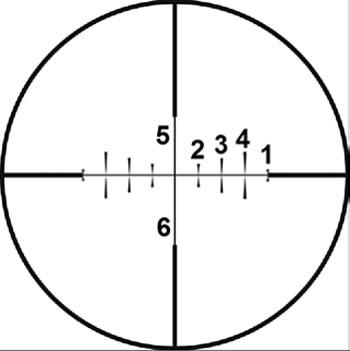
In the picture above, it shows the Huskemaw reticle with vertical lines coming off of the horizontal line. On 20x, the lines are separated by one MOA. There is 4 MOA of wind adjustment in the reticle, from the center crosshair going to the right or the left. If you move the power ring to 10x, it will subtend at 2 MOA per line. This is a quick and accurate way to dope the wind. If you so choose, you can use the windage turret that is marked from 0-10 each way from zero, with a total of 20 MOA, adjusting in 1/3 MOA increments per revolution. When I first looked through the Huskemaw scope, I instantly noticed the different lengths on the horizontal line. I thought it was a good way to avoid confusion, since the lines get progressively longer. However, I didn't realize until I read the manual that they can also be used for reticle ranging when needed. Very cool! If you know the back to brisket of the game you are hunting, you can quickly get a range to target with no math or calculator required. Each line has a number:
#1 for 9 inch targets
#2 for 12 inch targets
#3 for 18" targets
#4 for 24" targets,
#5 for 30" targets
#6 for 36 inch targets
Simply bracket the animal or target with the line for their size and turn the Huskemaw's power ring until the reticle fits right on the top and bottom of your intended target. Then, look at the power ring and read the distance to the target in hundreds of yards. It is just too easy! Since the horizontal line cuts it in half for targets of 4.5", 6", 12", 12", 15", and 18", it is easy to half the reticle. To use any kind of reticle ranging system accurately takes practice before you head to the fields in pursuit of game. With practice, most people can reticle range accurately enough for shots out to 500 yards or so. This can be the difference between filling a tag or going home empty-handed when your laser rangefinder fails or the conditions are such your rangefinder will not work. On a non-hunting note, there are some tactical matches today that do not allow the use of laser rangefinders. Just think how fast it would be to use this reticle for such a match. The Huskemaw scope employs an easy to use side focus or parallax adjustment which has become common for this class of scope. It is easy to use when in the shooting position. In fact, everything about this Huskemaw scope was designed for quick use in the field.
I have remarked several times that I have been impressed with this Huskemaw scope, and everything that comes with it. Regardless of quality of the product, it is the people who stand behind it that make it a true package deal. Since receiving this scope, I have spoken and emailed with several people at Best of the West, and all my conversations with them have been enjoyable and informative.
Most of my conversations have been with Aaron Davidson, Product Engineer for Best of the West. He impresses me as one who is not content with the "status quo," and is striving to make better products for people who shoot and hunt. You sense his passion for the sport while listening to him. One thing that Aaron told me after I received the scope was that an improved version was weeks away from being available. They were not satisfied with the way the zero stop was working and replaced the four screws on zero stop ring with one "clamping screw" like a Forrester reloading die lock ring. I had some frustration with the older style zero stop, but again, it was nice to know the issue had already been taken care of on new Huskemaw scopes.

One item that I have asked Aaron about was the amount of MOA available in the windage turret. One of my specialty pistols had offset holes for the base, and I ran out of windage when I put it on that handgun. After that I realized there is not as much MOA adjustment for wind (just over 40 MOA) as there is for elevation. This is the only thing I would change about this scope, and have shared that with Aaron. In typical Davidson style, he said he would see what could be done. Hunters do not usually get such a positive response from the shooting industry. There are others who make products for long range hunters, who approach business in a similar way like I stated above. Before I finished this article I emailed Aaron out of curiosity, to find out what are the most common questions and common comments from users of the Huskemaw scopes. Aaron replied, "How do I zero this thing?" or "I can't believe how far I can shoot!"
After reading this review, you may want to ask me, "Are you selling your Leupold VX-3, Mark 4, or your Nightforce scopes?" My answer is, "No." However, that is a good question. But I think there is a better one to ask: "Will Ernie use the Huskemaw 5-20 LR rifle scope on his best guns for big game hunting?" My answer would be, "Yes!" In fact, It is on my APS center-grip Remington XP-100 chambered in 7mm Dakota. I believe the consumer who chooses a Huskemaw scope is getting a great product at a great price.
________________________________________________________
About The Author:
Ernie Bishop resides in Gillette, Wyoming, where he serves as a preacher. He enjoys long range hunting for varmints and big game with handguns. Ernie also uses his specialty handguns in tactical style matches and in 1,000 yard competitions once or twice a year.

In the picture above, it shows the Huskemaw reticle with vertical lines coming off of the horizontal line. On 20x, the lines are separated by one MOA. There is 4 MOA of wind adjustment in the reticle, from the center crosshair going to the right or the left. If you move the power ring to 10x, it will subtend at 2 MOA per line. This is a quick and accurate way to dope the wind. If you so choose, you can use the windage turret that is marked from 0-10 each way from zero, with a total of 20 MOA, adjusting in 1/3 MOA increments per revolution. When I first looked through the Huskemaw scope, I instantly noticed the different lengths on the horizontal line. I thought it was a good way to avoid confusion, since the lines get progressively longer. However, I didn't realize until I read the manual that they can also be used for reticle ranging when needed. Very cool! If you know the back to brisket of the game you are hunting, you can quickly get a range to target with no math or calculator required. Each line has a number:
#1 for 9 inch targets
#2 for 12 inch targets
#3 for 18" targets
#4 for 24" targets,
#5 for 30" targets
#6 for 36 inch targets
Simply bracket the animal or target with the line for their size and turn the Huskemaw's power ring until the reticle fits right on the top and bottom of your intended target. Then, look at the power ring and read the distance to the target in hundreds of yards. It is just too easy! Since the horizontal line cuts it in half for targets of 4.5", 6", 12", 12", 15", and 18", it is easy to half the reticle. To use any kind of reticle ranging system accurately takes practice before you head to the fields in pursuit of game. With practice, most people can reticle range accurately enough for shots out to 500 yards or so. This can be the difference between filling a tag or going home empty-handed when your laser rangefinder fails or the conditions are such your rangefinder will not work. On a non-hunting note, there are some tactical matches today that do not allow the use of laser rangefinders. Just think how fast it would be to use this reticle for such a match. The Huskemaw scope employs an easy to use side focus or parallax adjustment which has become common for this class of scope. It is easy to use when in the shooting position. In fact, everything about this Huskemaw scope was designed for quick use in the field.
I have remarked several times that I have been impressed with this Huskemaw scope, and everything that comes with it. Regardless of quality of the product, it is the people who stand behind it that make it a true package deal. Since receiving this scope, I have spoken and emailed with several people at Best of the West, and all my conversations with them have been enjoyable and informative.
Most of my conversations have been with Aaron Davidson, Product Engineer for Best of the West. He impresses me as one who is not content with the "status quo," and is striving to make better products for people who shoot and hunt. You sense his passion for the sport while listening to him. One thing that Aaron told me after I received the scope was that an improved version was weeks away from being available. They were not satisfied with the way the zero stop was working and replaced the four screws on zero stop ring with one "clamping screw" like a Forrester reloading die lock ring. I had some frustration with the older style zero stop, but again, it was nice to know the issue had already been taken care of on new Huskemaw scopes.

One item that I have asked Aaron about was the amount of MOA available in the windage turret. One of my specialty pistols had offset holes for the base, and I ran out of windage when I put it on that handgun. After that I realized there is not as much MOA adjustment for wind (just over 40 MOA) as there is for elevation. This is the only thing I would change about this scope, and have shared that with Aaron. In typical Davidson style, he said he would see what could be done. Hunters do not usually get such a positive response from the shooting industry. There are others who make products for long range hunters, who approach business in a similar way like I stated above. Before I finished this article I emailed Aaron out of curiosity, to find out what are the most common questions and common comments from users of the Huskemaw scopes. Aaron replied, "How do I zero this thing?" or "I can't believe how far I can shoot!"
After reading this review, you may want to ask me, "Are you selling your Leupold VX-3, Mark 4, or your Nightforce scopes?" My answer is, "No." However, that is a good question. But I think there is a better one to ask: "Will Ernie use the Huskemaw 5-20 LR rifle scope on his best guns for big game hunting?" My answer would be, "Yes!" In fact, It is on my APS center-grip Remington XP-100 chambered in 7mm Dakota. I believe the consumer who chooses a Huskemaw scope is getting a great product at a great price.
________________________________________________________
About The Author:
Ernie Bishop resides in Gillette, Wyoming, where he serves as a preacher. He enjoys long range hunting for varmints and big game with handguns. Ernie also uses his specialty handguns in tactical style matches and in 1,000 yard competitions once or twice a year.

